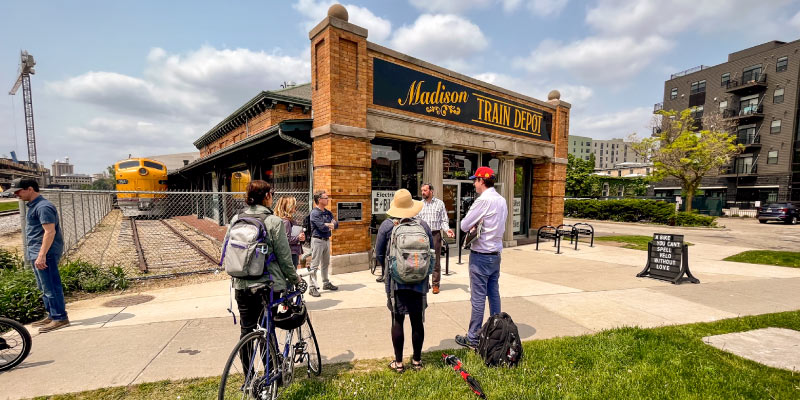 It’s 61 degrees — a warm 61 — with mostly sunny skies save for a haze brought down by the Canadian wildfires. Trees are in full bloom, dandelions have turned to fuzz, and the soundtrack of construction sets the mood as a group of Nelson Institute graduate students and staff convene in front of the Motorless Motion bike shop on Madison’s West Washington Avenue. They’re here for the Center for Culture, History, and Environment (CHE)’s place-based workshop: “The Rail and Trail Ecologies of Wisconsin.”
It’s 61 degrees — a warm 61 — with mostly sunny skies save for a haze brought down by the Canadian wildfires. Trees are in full bloom, dandelions have turned to fuzz, and the soundtrack of construction sets the mood as a group of Nelson Institute graduate students and staff convene in front of the Motorless Motion bike shop on Madison’s West Washington Avenue. They’re here for the Center for Culture, History, and Environment (CHE)’s place-based workshop: “The Rail and Trail Ecologies of Wisconsin.”
The place-based workshop is an annual event, held since 2007, that takes graduate students and faculty associates out of the classroom and into the field to explore the complex relationships between culture and nature. The started their three-day tour of Wisconsin’s rail tracks and bike trails on West Washington Avenue because the space, now occupied by shops and upscale restaurants, used to be the old Milwaukee Road Depot — Madison’s main hub for train activity from 1903–71. At the historic intersection, Scott Lothes and Heather Sonntag from the Center for Railroad Photography and Art started the workshop with an in-depth look at the history of not only the space, but the Milwaukee Road line, which in its heyday, spanned 11,252 miles across the Midwest and West.
The group then walked the Southwest Commuter Path, which runs alongside the tracks, to Union South, for an afternoon of guest lectures that covered everything from Madison’s rail history to the role of Black women in the American railroad. Day one concluded with a five-mile walk around Madison’s Dudgeon-Monroe neighborhood, mapped out by UW PhD candidate John Canfield.
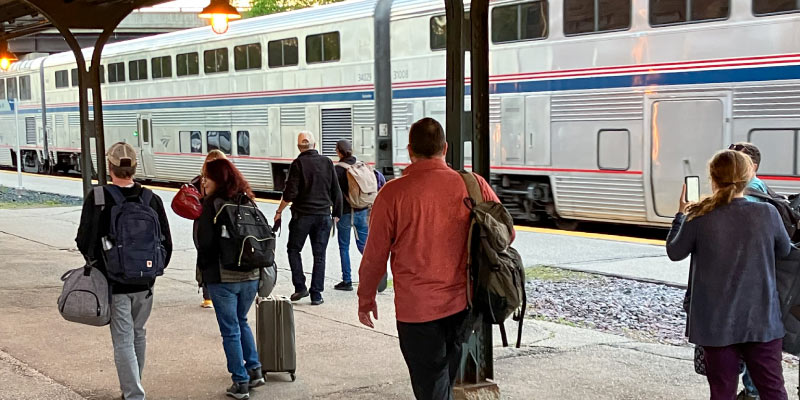 The following day, the group bused from Memorial Union to downtown Milwaukee for a walking tour of historic train sites before boarding the Empire Builder train at the Milwaukee Intermodal Station, which they rode to La Crosse, Wisconsin. The final day of the workshop started with a tour of La Crosse-area railroad sites and culminated in a bike ride along the Elroy-Sparta Trail — a popular biking and walking trail that was converted from a railroad line in 1967.
The following day, the group bused from Memorial Union to downtown Milwaukee for a walking tour of historic train sites before boarding the Empire Builder train at the Milwaukee Intermodal Station, which they rode to La Crosse, Wisconsin. The final day of the workshop started with a tour of La Crosse-area railroad sites and culminated in a bike ride along the Elroy-Sparta Trail — a popular biking and walking trail that was converted from a railroad line in 1967.
Throughout the experience, students were asked to capture their experiences and reflections through a variety of media, including photos, videos, poems, and essays. Tessa Archambault, a PhD student who attended the workshop, wrote an essay documenting her experience of the train ride from Milwaukee to La Crosse.
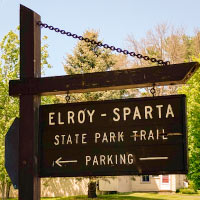 Rail Reflections
Rail Reflections
By Tessa Archambault
It’s not everyday you get a fresh perspective on the state you call home. While I’m not sure what I expected to gain from this year’s CHE place-based workshop on rail and trail ecologies, that is what I got: a new take on Wisconsin. A short visit to both Milwaukee and La Crosse via train offered the chance to take in the lush and green countryside of late May as well as some of the industrial structures that define some of those landscapes. These included train tracks and tunnels, a swinging rail bridge across the Mississippi, and the urban spaces of downtown Milwaukee, its historic Third Ward, and the stretches of city along the river and shores of Lake Michigan. The rich yet stark contrasts from one place to the next figured prominently throughout the weekend.
Starting out early on both days allowed us to make the most of a compact and full schedule, but it also created space to be present for different periods of the day: bright mornings, weightier afternoons, and one mellow evening sunset. The quality of spring light, shifting throughout the day, accentuated the colors of both the urban and rural scenery as we moved from Madison to Milwaukee to La Crosse and onto the Elroy-Sparta bike trail before venturing back to Madison again. But equally important were modes of transportation: train, bus, bike, streetcar (briefly!), and on foot. They provided opportunities to see and experience these places from unusual angles throughout the weekend. Particularly striking were some of the historic rail structures in Milwaukee as well as the beautiful views from the train ride across southern Wisconsin.
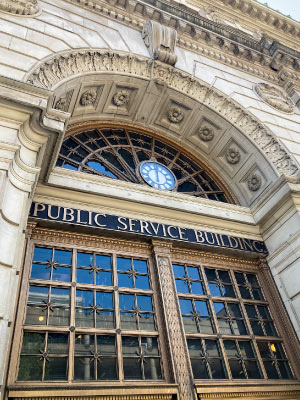 In Milwaukee, an informal walking tour was the ideal way to notice the shifts taking place between old and new, to get a feel for the history of rail transportation here, and to admire some of the city’s unique buildings. The Public Service Building, for example, is beautiful to look at from the street. A large and imposing structure, it dates back to 1905 and is an example of Beaux-Arts neoclassical architecture. The unique ornamentation on its façade points to the transitions between different forms of transportation, from horse-drawn carriage to electric streetcar. Taking up a whole city block, the building originally served as the central terminal for the interurban rail system and the headquarters for the Milwaukee Electric Railway and Light Company. Its size and scale combined with the attention given to its architectural design and detail point to the past importance of public rail transportation, before automobiles became a commonplace feature of American life. Although the building was closed that Saturday, we were able to peer in at its famous marble lobby and staircase through the windows.
In Milwaukee, an informal walking tour was the ideal way to notice the shifts taking place between old and new, to get a feel for the history of rail transportation here, and to admire some of the city’s unique buildings. The Public Service Building, for example, is beautiful to look at from the street. A large and imposing structure, it dates back to 1905 and is an example of Beaux-Arts neoclassical architecture. The unique ornamentation on its façade points to the transitions between different forms of transportation, from horse-drawn carriage to electric streetcar. Taking up a whole city block, the building originally served as the central terminal for the interurban rail system and the headquarters for the Milwaukee Electric Railway and Light Company. Its size and scale combined with the attention given to its architectural design and detail point to the past importance of public rail transportation, before automobiles became a commonplace feature of American life. Although the building was closed that Saturday, we were able to peer in at its famous marble lobby and staircase through the windows.
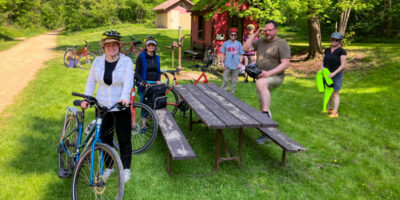 Thoughts of rail history and the prominence of the railroad carried over into the evening as we made our way from Milwaukee to La Crosse on the Amtrak’s Empire Builder, a line that extends from Chicago all the way to the Pacific Northwest. Having taken trains many times while traveling and living overseas, I found myself repeatedly surprised that this was my first time doing so in the U.S. While it all felt very familiar, this kind of travel is very out of the ordinary for us here, particularly in the Midwest. Even more surprising were the views from the train. The four-hour ride provided plenty of time to take in the long stretches of changing scenery along the way. The train’s carriage car was designed specifically for that purpose. Large windows line both sides of the car, extending upwards to allow passengers to gaze out as much as possible, while the seats all face toward the windows rather than lined up in rows facing the exits in the other passenger cars. It gave a sense of being fully immersed in the late afternoon countryside, generating a feeling of nearness to the fields, bluffs, and the Wisconsin River as the train crossed through Wisconsin Dells. While it’s perhaps faster to make the trip via car, taking the train, and especially riding in the carriage car, encouraged a sense of wonder about the state’s natural beauty that isn’t always obvious from I-94. It also generated a feeling of connection to the other passengers on the train, something that doesn’t typically happen within the confines of a car.
Thoughts of rail history and the prominence of the railroad carried over into the evening as we made our way from Milwaukee to La Crosse on the Amtrak’s Empire Builder, a line that extends from Chicago all the way to the Pacific Northwest. Having taken trains many times while traveling and living overseas, I found myself repeatedly surprised that this was my first time doing so in the U.S. While it all felt very familiar, this kind of travel is very out of the ordinary for us here, particularly in the Midwest. Even more surprising were the views from the train. The four-hour ride provided plenty of time to take in the long stretches of changing scenery along the way. The train’s carriage car was designed specifically for that purpose. Large windows line both sides of the car, extending upwards to allow passengers to gaze out as much as possible, while the seats all face toward the windows rather than lined up in rows facing the exits in the other passenger cars. It gave a sense of being fully immersed in the late afternoon countryside, generating a feeling of nearness to the fields, bluffs, and the Wisconsin River as the train crossed through Wisconsin Dells. While it’s perhaps faster to make the trip via car, taking the train, and especially riding in the carriage car, encouraged a sense of wonder about the state’s natural beauty that isn’t always obvious from I-94. It also generated a feeling of connection to the other passengers on the train, something that doesn’t typically happen within the confines of a car.
Although I’ve lived in Wisconsin for the last five years, I have much more to discover in the state’s various histories and landscapes. Doing so through the lens of the railroad offered a different vantage point from the typical things Wisconsin is known for, like long winters and numerous lakes, cheese and Wisconsin Dells waterparks. I look forward to revisiting some of the places we explored over that weekend, and to taking the train the next time I can.